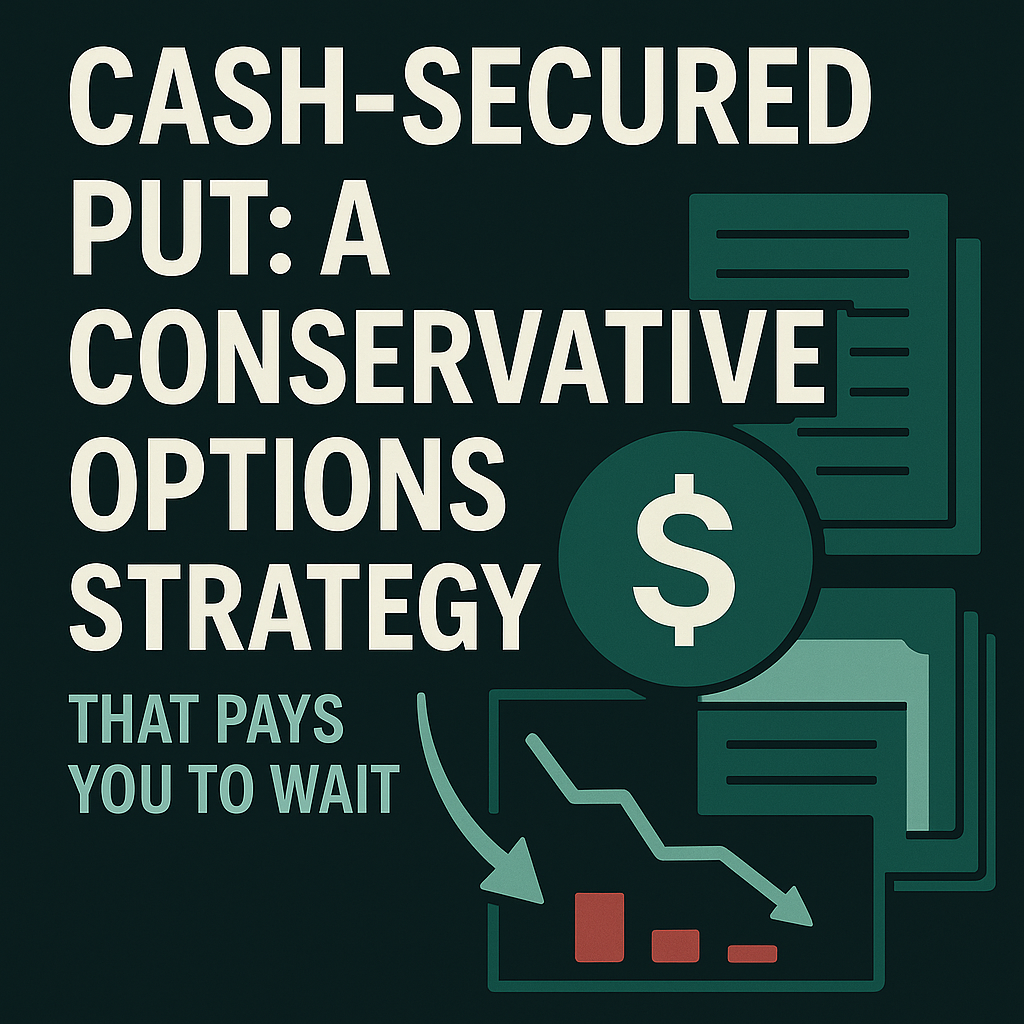Cash-Secured Put: A Conservative Options Strategy That Pays You to Wait

In the world of options trading, not every strategy is about betting on dramatic moves. Sometimes, the best plays are the ones where you get paid to wait. The Cash-Secured Put (CSP) is a prime example — a conservative, income-generating strategy that works best when you wouldn’t mind owning the stock anyway.
In this post, we’ll explore how the Cash-Secured Put works, what the risk/reward profile looks like, and how strike selection and expiration dates can drastically change your outcomes.
What Is a Cash-Secured Put?
A Cash-Secured Put involves selling a put option while holding enough cash in your account to buy 100 shares of the stock at the strike price. If the stock drops and the put is exercised, you’ll be obligated to buy the stock — but that’s exactly what you planned for.
You collect a premium up front, and if the stock stays above the strike price, the option expires worthless and you keep the cash.
Max Profit and Max Loss
Max Profit:
The maximum profit is the premium collected when selling the put. For example, if you sell a $90 put for $2.00, you receive $200 per contract. This is yours to keep regardless of what happens, as long as the option is not assigned.
Max Loss:
The worst-case scenario is that the stock falls to $0, and you are obligated to buy at the strike price.
Your max loss = Strike Price – Premium Collected, multiplied by 100 shares.
In our example, that’s:
$90 – $2 = $88 x 100 = $8,800 maximum potential loss.
While this looks scary, remember: your intention is to own the stock, so this “loss” only materializes if the stock goes to zero.
Break-Even Price:
Strike Price – Premium Collected
→ $90 – $2 = $88
Why Use a Cash-Secured Put?
1. You Want to Buy the Stock at a Lower Price
If there’s a stock you like, but it’s a bit overvalued, selling a put at a lower strike lets you get paid while waiting for a better entry point.
2. You Want Income From Cash
Instead of letting idle cash sit in a brokerage account, you can earn premium income by taking on potential stock ownership.
3. Defined Risk, Passive Strategy
You can’t lose more than what you’ve already set aside to buy the stock. This makes it safer than naked puts or margin trades.
4. Boosted Yield
Even if you get assigned, your effective purchase price is lower thanks to the premium collected. This can boost your yield on long-term holdings.
How Strike Price and Expiration Matter
Your choice of strike price and expiration determines your risk, return, and probability of assignment.
1. Strike Price Selection
- Out-of-the-Money (OTM) Put:
Strike below current stock price (e.g., stock is $95, you sell $90 put)
→ Less premium, lower chance of assignment
→ More conservative - At-the-Money (ATM) Put:
Strike near current stock price
→ More premium, higher chance of assignment
→ Higher risk/reward - In-the-Money (ITM) Put:
Strike above current price
→ Highest premium, almost certain assignment
→ Used by traders who really want the stock
🧠 Tip: Use OptionsProfitCalculator.com to simulate how various strike prices affect your returns.
2. Expiration Date Selection
- Short-Term (Weekly/Monthly):
→ Faster premium decay, higher income potential
→ But you must manage more frequently - Long-Term (LEAPS):
→ Slower decay, less frequent monitoring
→ More time for the stock to dip
The closer to expiration, the faster time value (theta) decays — so shorter-term CSPs generally earn more annualized yield but need more attention.
Example Scenario
Let’s say you’re eyeing XYZ stock, currently trading at $95, and wouldn’t mind owning it at $90.
You sell a $90 put, expiring in 30 days, and collect $2.00 premium.
- You receive $200 up front.
- You set aside $9,000 in cash in case you’re assigned.
- If XYZ stays above $90 at expiration, the option expires worthless and you keep the $200.
- If XYZ drops to $85, you get assigned and buy the shares at $90 — but your effective price is $88.
- If XYZ goes to zero, your max loss is $8,800.
This is a high-probability strategy with solid returns — especially in flat or slightly bullish markets.
Key Takeaways
- A Cash-Secured Put is a conservative, income-generating strategy for bullish or neutral markets.
- You collect premium upfront and may be assigned if the stock falls below the strike.
- Max profit is the premium; max loss occurs if the stock goes to zero.
- Your break-even is the strike price minus the premium collected.
- Selecting the right strike and expiration balances income vs. risk of assignment.
Before you place your next trade, try modeling it at OptionsProfitCalculator.com — see your potential outcomes before putting cash on the line.